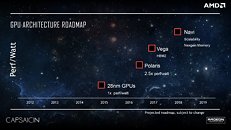Monday, May 8th 2017

AMD to Detail Vega, Navi, Zen+ on May 16th - Laying Out a Vision
Reports are circling around the web regarding an AMD meeting featuring some of its higher ups - namely, CEO Lisa Su, head of Radeon Technologies Group Raja Koduri, and AMD's CTO Mark Papermaster happening on the 16th of May. The purpose of this meeting seems to be to discuss AMD's inflexion point, and lay out a vision for the company's future, supported on its upcoming products: the too-long-awaited Vega, its successor Navi, and the natural evolution of the company's current Zen processors, tentatively identified as Zen+.
Naturally, a company such as AMD has its roadmap planned well in advance, with work on next-generation products and technologies sometimes even running in parallel with current-generation product development. It's just a result of the kind of care, consideration, time and money that goes into making new architectures that makes this so. And while some would say Vega is now approaching a state akin to grapes that have been hanging for far too long, AMD's next graphics architecture, Navi, and its iterations on Zen cores, which the company expect to see refreshes in a 3-to-5-year period, are other matters entirely. Maybe we'll have some more details regarding the specific time of Vega's launch (for now expected on Computex), as well as on when AMD is looking to release a Zen+ refresh. I wouldn't expect much with regards to Navi - perhaps just an outline on how work is currently underway with some comments on the expectations surrounding Global Foundries' 7 nm process, on which Navi is expected to be built. And no, folks, this isn't a Vega launch. Not yet.
Source:
WCCFTech
Naturally, a company such as AMD has its roadmap planned well in advance, with work on next-generation products and technologies sometimes even running in parallel with current-generation product development. It's just a result of the kind of care, consideration, time and money that goes into making new architectures that makes this so. And while some would say Vega is now approaching a state akin to grapes that have been hanging for far too long, AMD's next graphics architecture, Navi, and its iterations on Zen cores, which the company expect to see refreshes in a 3-to-5-year period, are other matters entirely. Maybe we'll have some more details regarding the specific time of Vega's launch (for now expected on Computex), as well as on when AMD is looking to release a Zen+ refresh. I wouldn't expect much with regards to Navi - perhaps just an outline on how work is currently underway with some comments on the expectations surrounding Global Foundries' 7 nm process, on which Navi is expected to be built. And no, folks, this isn't a Vega launch. Not yet.


17 Comments on AMD to Detail Vega, Navi, Zen+ on May 16th - Laying Out a Vision
It's a meeting with investors & financial analysts where AMD updates the roadmap, as they have done previously, with technical details at a minimum and no bling bling for consumers.
Modern game workloads are made up of thousands of simultaneous interdependent threads that share data and migrate across CPU cores all the time. Having a cross CCX latency that is 3 times as high as Ryzen/Kaby Lake core-to-core latency is just extremely inefficient for this type of workloads.
Why the hell did they release 2-CCX CPUs? Why release 8 and 6 core CPUs for a market that doesn't need more than 4-core CPUs? 99.9% of games are console ports. Those games are made to run on crappy 8-cores Jaguar CPUs.
They could've release higher clocked single CCX quad cores that would have performed roughly as well as Kaby Lake quads in both gaming and general workloads.
They shot themselves in the foot and now they're back hyping again. What a sleazy company full of sleazy people and unqualified retards (Kadouri).
LE: Found it.
My PC most vehemently disagrees with you. A 1080ti with a Ryzen at 3.9Ghz is so smooth it makes me giggle.
So in short, AMD could've had a 3.8GHZ to 4.0GHz base frequency 4-core CPU for many months now that would've been roughly 15% to 20% faster than the R5 1500X (pretty close to the 7700K) in non-gaming workloads, and as fast as Kaby Lake in games, in addition to being a good overclocker.
I wonder if anyone else in the same boat felt like AMD was taunting us with the 580....
When you look at a lot of the reviews, they clearly agree with the above statements regarding CCX-CCX latencies and even a very general engineering approach to the system in question would quite clearly hint that the design is inherently flawed for the realistic workloads. The optimisation for it is basically going to be isolating interdependent threads to one CCX, but in that case why would anyone who is not going to spam CPU based rendering tasks on their system ever consider getting more than a single CCX quad core... And heaven forbid AMD decide to make the quads 2-CCX...
I would very much have liked to get an all AMD rig in the next year or so, but the chances of it happening are beginning to look more and more slim, especially with how disappointing the OGL performance of AMDs cards has been. On top of all the patchiness in AMDs approach to the memory compatibility on Ryzen. I really just want a computer that works, and so far neither intel or nvidia have let me down in this regard, but I have doubts as to whether AMD would hold up to my expectations.
This just shows how bad Ryzen is for game workloads and how good it could've been had AMD released a single CCX quad core and clocked it competitively.
here's the link:
arstechnica.com/gadgets/2017/05/amd-ryzen-5-review-1600x/2/
The architecture itself seems to be, just like with the CMT archs, inherently flawed for basically all practical usage scenarios, at least as far as gaming is concerned.